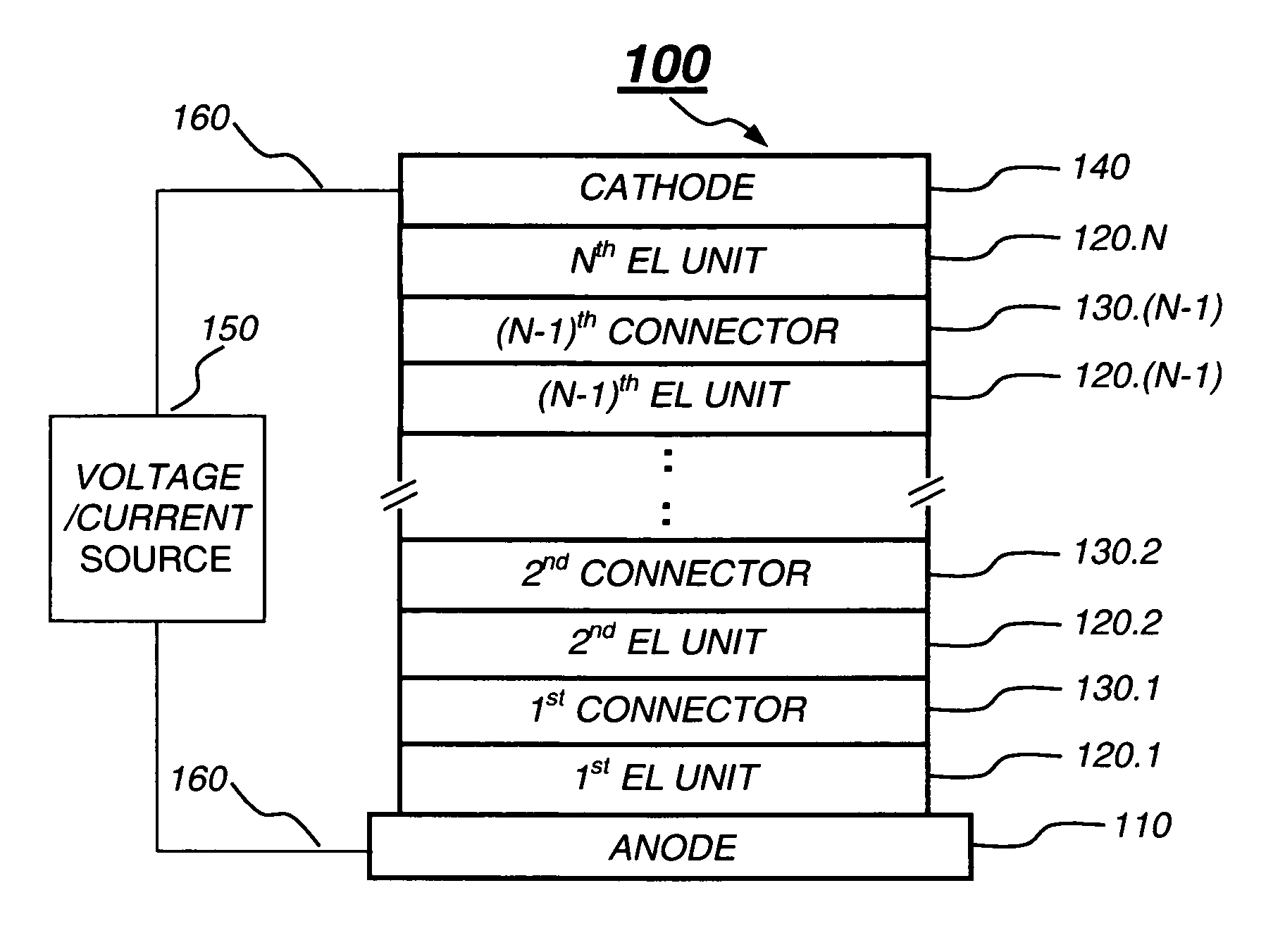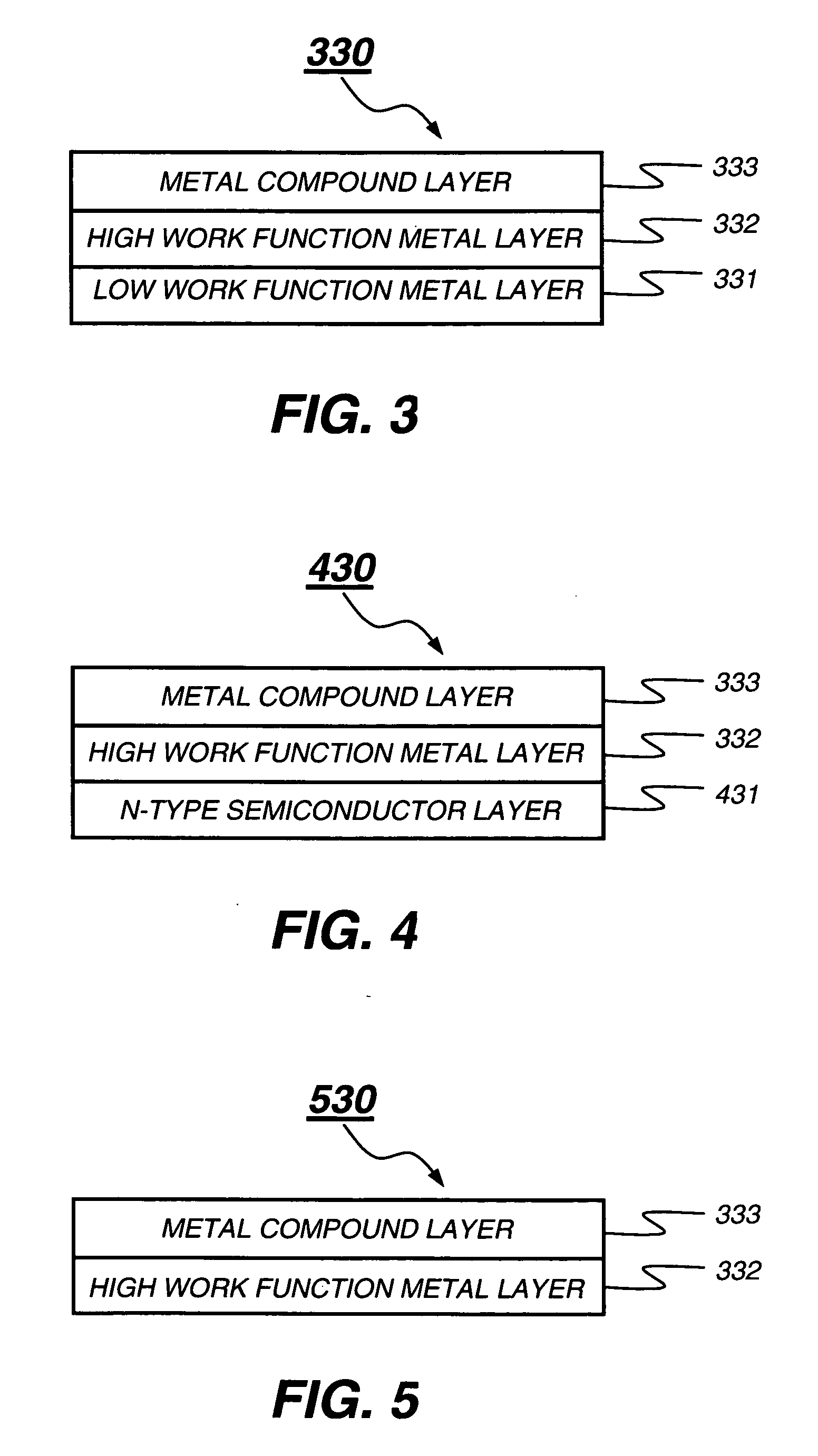Tandem OLED having stable intermediate connectors
a technology of intermediate connectors and oleds, which is applied in the direction of discharge tube luminescnet screens, organic semiconductor devices, natural mineral layered products, etc., can solve the problems of pixel crosstalk, damage to the underlying organic layer, and high toxic substances, so as to improve the operation stability of tandem oleds, reduce the drive voltage of tandem oleds, and increase the power efficiency of tandem oleds
- Summary
- Abstract
- Description
- Claims
- Application Information
AI Technical Summary
Benefits of technology
Problems solved by technology
Method used
Image
Examples
examples
[0116] The following examples are presented for a further understanding of the present invention. For purposes of brevity, the materials and layers formed therefrom will be abbreviated as given below: [0117] ITO: indium-tin-oxide; used in forming the transparent anode on glass substrates; [0118] CFx: polymerized fluorocarbon layer; used in forming a hole-injecting layer on top of ITO; [0119] NPB: N,N′-di(naphthalene-1-yl)-N,N′-diphenyl-benzidine; used in forming the hole-transporting layer in the organic EL unit; [0120] Alq: tris(8-hydroxyquinoline) aluminum(III); used both as the host in forming the light-emitting layer and used as the host in forming the n-type doped electron-transporting layer in the organic EL unit; [0121] C545T: 10-(2-benzothiazolyl)-1,1,7,7-tetramethyl-2,3,6,7-tetrahydro-1H,5H,11H(1)benzopyrano(6,7,8-ij)quinolizin-11-one; used as a green dopant in the light-emitting layer in the EL unit; [0122] Li: Lithium; used as n-type dopant in forming the n-type doped ele...
example 2
Comparative
[0133] A tandem OLED was constructed in the manner described in Example 1, and the deposited layer structure is: [0134] 1. 1st EL Unit: [0135] a) an HTL, about 100 nm thick, including NPB; [0136] b) a LEL, 20 nm thick, including Alq doped 1.0 vol. % C545T; and [0137] c) a first ETL, 40 nm thick, including Alq doped with 1.2 vol. % Li. [0138] 2. 1st Intermediate Connector: [0139] a) a high work function metal layer, 10 nm thick, including Ag. [0140] 3. 2nd EL Unit: [0141] a) an HTL, about 70 nm thick, including NPB; [0142] b) a LEL, 20 nm thick, including Alq doped 1.0 vol. % C545T; and [0143] c) a first ETL, 40 nm thick, including Alq doped with 1.2 vol. % Li. [0144] 4. Cathode: approximately 210 nm thick, including MgAg.
[0145] This tandem OLED requires a drive voltage of about 22.9 V to pass 20 mA / cm2. Under this testing condition, the device has a luminance of 937 cd / m2, luminous efficiency of about 4.68 cd / A, and power efficiency of about 0.64 lm / W. Its CIEx and CIEy...
example 3
Comparative
[0146] A tandem OLED was constructed in the manner described in Example 2, and the deposited layer structure is: [0147] 1. 1st EL Unit: [0148] a) an HTL, about 90 nm thick, including NPB; [0149] b) a LEL, 30 nm thick, including Alq doped 1.0 vol. % C545T; and [0150] c) a first ETL, 30 nm thick, including Alq doped with 1.2 vol. % Li. [0151] 2. 1st Intermediate Connector: [0152] a) a metal compound layer, 2 nm thick, including MoO3. [0153] 3. 2nd EL Unit: [0154] a) an HTL, about 88 nm thick, including NPB; [0155] b) a LEL, 30 nm thick, including Alq doped 1.0 vol. % C545T; and [0156] c) a first ETL, 30 nm thick, including Alq doped with 1.2 vol. % Li. [0157] 4. Cathode: approximately 210 nm thick, including MgAg.
[0158] This tandem OLED requires a drive voltage of 14.3 V to pass 20 mA / cm2. Under this testing condition, the device has a luminance of 4781 cd / m2, luminous efficiency of about 23.9 cd / A, and power efficiency of about 5.24 lm / W. Its CIEx and CIEy are 0.267, 0.6...
PUM
| Property | Measurement | Unit |
|---|---|---|
| sheet resistance | aaaaa | aaaaa |
| thickness | aaaaa | aaaaa |
| thickness | aaaaa | aaaaa |
Abstract
Description
Claims
Application Information
 Login to View More
Login to View More - R&D
- Intellectual Property
- Life Sciences
- Materials
- Tech Scout
- Unparalleled Data Quality
- Higher Quality Content
- 60% Fewer Hallucinations
Browse by: Latest US Patents, China's latest patents, Technical Efficacy Thesaurus, Application Domain, Technology Topic, Popular Technical Reports.
© 2025 PatSnap. All rights reserved.Legal|Privacy policy|Modern Slavery Act Transparency Statement|Sitemap|About US| Contact US: help@patsnap.com



